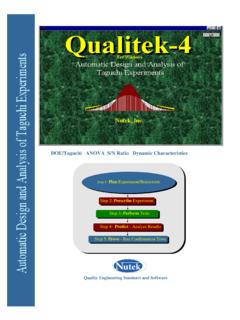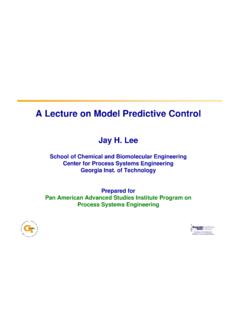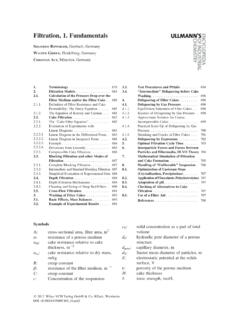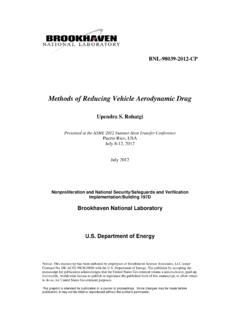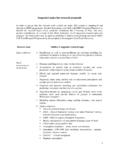Transcription of Design of Experiments (DOE) Using the Taguchi Approach
1 Design of Experiments (DOE) Using the Taguchi Approach This document contains brief reviews of several topics in the technique. For summaries of the recommended steps in application, read the published article attached. (Available for free download and review.) TOPICS: Subject Overview References Taguchi Method Review Application Procedure Quality Characteristics Brainstorming Factors and Levels Interaction Between Factors Noise Factors and Outer Arrays Scope and Size of Experiments Order of Running Experiments Repetitions and Replications Available Orthogonal Arrays Triangular Table and Linear Graphs Upgrading Columns Dummy Treatments Results of Multiple Criteria S/N Ratios for Static and Dynamic Systems Why Taguchi Approach and Taguchi vs.
2 Classical DOE Loss Function General Notes and Comments Helpful Tips on Applications Quality Digest Article experiment Design Solutions Common Orthogonal Arrays Other References: 1. DOE : 2. 16 Steps to 3. Read an independent review of Qualitek-4: 4. A Strategy for Simultaneous Evaluation of Multiple Objectives, A journal of the Reliability Analysis Center, 2004, Second quarter, Pages 14 - 18. 5. Design of Experiments Using the Taguchi Approach : 16 Steps to Product and Process Improvement by Ranjit K. Roy Hardcover - 600 pages Bk&Cd-Rom edition (January 2001) John Wiley ISBN: 0471361011 6. Primer on the Taguchi Method - Ranjit Roy (ISBN:087263468X Originally published in 1989 by Van Nostrand Reinhold.)
3 Current publisher/source is Society of Manufacturing Engineers). The book is available directly from the publisher, Society of Manufacturing Engineers (SME ) Box 6028, Dearborn, Michigan 48121, Pages. 50 Illustrations. Order code: 2436-2487. For open enrollment seminar on Taguchi DOE technique, visit . Nutek, Inc. Bloomfield Hills, MI. USA. Tel: 1-248-540-4827 0607 Page 2 Subject Overview (The Taguchi Approach ) Design Of Experiments (DOE) is a powerful statistical technique introduced by R. A. Fisher in England in the 1920's to study the effect of multiple variables simultaneously. In his early applications, Fisher wanted to find out how much rain, water, fertilizer, sunshine, etc.
4 Are needed to produce the best crop. Since that time, much development of the technique has taken place in the academic environment, but did help generate many applications in the production floor. As a researcher in Electronic Control Laboratory in Japan, Dr. Genechi Taguchi carried out significant research with DOE techniques in the late 1940's. He spent considerable effort to make this experimental technique more user-friendly (easy to apply) and applied it to improve the quality of manufactured products. Dr. Taguchi 's standardized version of DOE, popularly known as the Taguchi method or Taguchi Approach , was introduced in the USA in the early 1980's.
5 Today it is one of the most effective quality building tools used by engineers in all types of manufacturing activities. The DOE Using Taguchi Approach can economically satisfy the needs of problem solving and product/process Design optimization projects. By learning and applying this technique, engineers, scientists, and researchers can significantly reduce the time required for experimental investigations. DOE can be highly effective when yow wish to: - Optimize product and process designs, study the effects of multiple factors ( variables, parameters, ingredients, etc.) on the performance, and solve production problems by objectively laying out the investigative Experiments .
6 (Overall application goals). - Study Influence of individual factors on the performance and determine which factor has more influence, which ones have less. You can also find out which factor should have tighter tolerance and which tolerance should be relaxed. The information from the experiment will tell you how to allocate quality assurance resources based on the objective data. It will indicate whether a supplier's part causes problems or not (ANOVA data), and how to combine different factors in their proper settings to get the best results (Specific Objectives). Further, the experimental data will allow you determine.
7 - How to substitute a less expensive part to get the same performance improvement you propose - How much money you can save the Design - How you can determine which factor is causing most variations in the result - How you can set up your process such that it is insensitive to the uncontrollable factors - Which factors have more influence on the mean performance - What you need to do to reduce performance variation around the target - How your response varies proportional to signal factor (Dynamic response) - How to combine multiple criteria of evaluation into a single index - How you can adjust factor for overall satisfaction of criteria an adjust factors for a system whose of evaluations - How the uncontrollable factors affect the performance etc.
8 , Advantage of DOE Using Taguchi Approach The application of DOE requires careful planning, prudent layout of the experiment , and expert analysis of results. Based on years of research and applications Dr. Genechi Taguchi has standardized the methods for each of these DOE application steps described below. Thus, DOE Using theTaguchi Approach has become a much more attractive tool to practicing engineers and scientists. experiment planning and problem formulation - experiment planning guidelines are consistent with modern work disciplines of working as teams. Consensus decisions about experimental objectives and factors make the projects more successful. experiment layout -High emphasis is put on cost and size of Size of the experiment for a given number of factors and levels is Approach and priority for column assignments are Clear guidelines are available to deal with factors and interactions (interaction tables).
9 Uncontrollable factors are formally treated to reduce Discrete prescriptions for setting up test conditions under uncontrollable factors are Guidelines for carrying out the Experiments and number of samples to be tested are defined Data analysis -Steps for analysis are standardized (main effect, NOVA and Optimum).. Standard practice for determination of the optimum is Guidelines for test of significance and pooling are Nutek, Inc. Bloomfield Hills, MI. USA. Tel: 1-248-540-4827 0607 Page 3 Interpretation of results - Clear guidelines about meaning of error Discrete indicator about confirmation of results (Confidence interval).
10 Ability to quantify improvements in terms of dollars (Loss function) Overall advantage - DOE Using Taguchi Approach attempts to improve quality which is defined as the consistency of performance. Consistency is achieved when variation is reduced. This can be done by moving the mean performance to the target as well as by reducing variations around the target. The prime motivation behind the Taguchi experiment Design technique is to achieve reduced variation (also known as ROBUST Design ). This technique, therefore, is focused to attain the desired quality objectives in all steps. The classical DOE does not specifically address quality.
